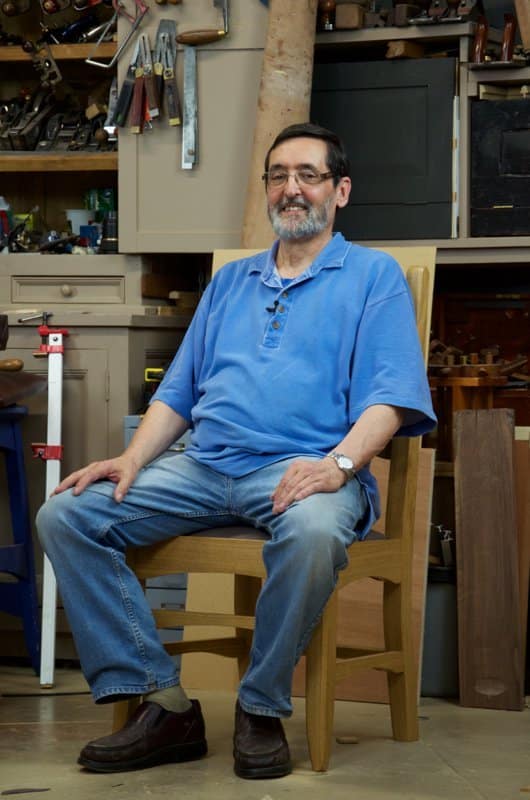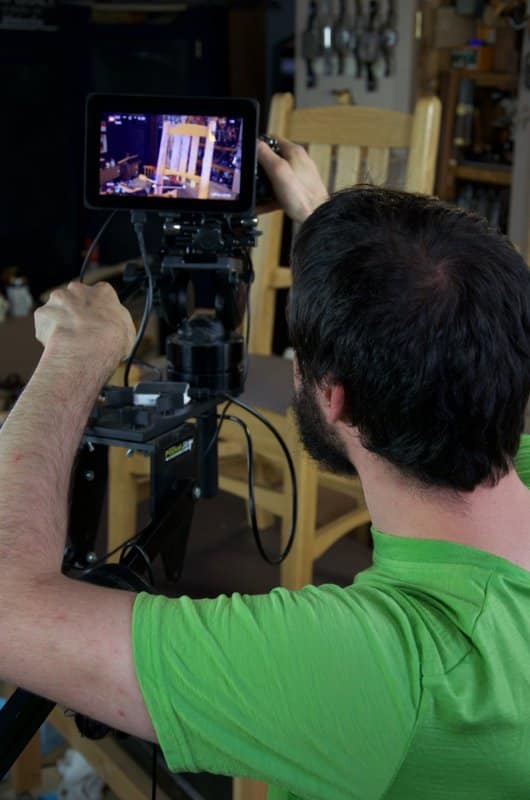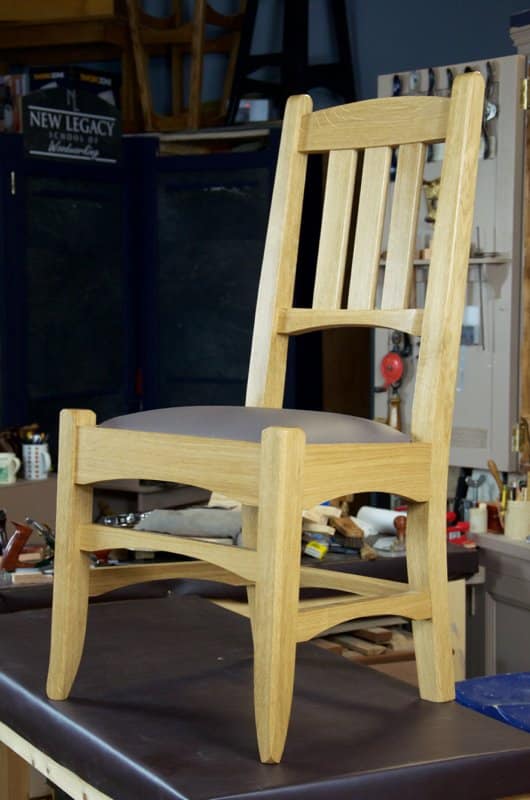Imagine hundreds of people making your chair
How do you explain closure when it’s just the start.

We parcelled things up into a neat package and a video of eight to ten to show thousands of woodworkers striving for skilled hand work how they too can make a chair with two hands, one joint type and ten common hand tools. No, of course we are looking for skill not machine work. This chair came from a plank of 8/4 European oak and some 4/4 boards. 4 board feet of 8/4, that is, and 3board feet of 4/4. That’s about £30 in the UK and a lot less in the USA.
I used some nice greyish leather on my oak chair and finished it with 5 coats of shellac followed by some soft paste wax I get from the National Trust here. We made video on upholstering the chairs i make for You Tube and will post that when the series has gone out via woodworkingmasterclasses.com which starts in about four weeks time.
My finished chair stands as a frame in three dimensional stability as I drift into a fourth dimension thinking how it will transform wood into objects of loveliness as others around the globe discover the same loveliness in the making of their own.
This will be the last mention until the series begins but I wanted you all to see the kind of contentedness I feel from my hand work.


Paul,
Have a question for you – there is a gap in the back of the chair between the seat and rungs that looks to be 6″ or more. On most chairs I have seen this gap is more like 2″. Is there a reason for this other than aesthetics? Thank you.
Yes, that part of the chair is rarely ever used and remember that a dining chair is actually considered a work chair. During dining people rarely lean back until after the meal and even then, for the majority of meals, only for a few minutes because of normal demands of work life and such. Aesthetically, at the end of the day, it’s what the designer wants and what the customer likes that matters, so it’s all optional and the chair can indeed be altered simply.
A chair should be sturdy, not frail; its role is support, not entertainment. Appearances may deceive, but Paul’s chair looks like it is ready for several lifetimes of duty. And while a kitchen utensil may be light and artistic, and functional for a year or two–no one expects a utensil to last generations. (Well, no one I know). A chair, a chest, a table–these are for a lifetime–the only question is…..the lifetime of the craftsman, or the lifetime of the wood. Well-made, a product of good wood, good craftsmanship and good care will last literally generations. A gift from the now to the future, when the future is not yet even born.
In my 50 years of making I have never had to repair a single piece I’ve made and never had one returned but for two where a customer felt the walls of her solid brick house wouldn’t hold the cabinets I custom made for her. They now house my special planes and books. The benefit is I would never have indulged myself with such lovely pieces for my workshop, but there they are to stay
Paul, this is a question that is slightly off topic, but I’d like satisfaction, also. (We’re both old enough to remember the song.)
Over here in North America, which you so wisely left to go back home, we have different standard lumber sizes. 4/4 lumber isn’t so easy — eyes glaze over when I ask for it in the lumber yard. Some of these fellows are still learning how to shave.
I’ll be interested in seeing the chair built. Sturdy upright chairs, even unupholstered, are becoming more and more comfortable, personally. But the problem crops up elsewhere, also. I like to make walking sticks and canes, but you simply ripped down a tapered blank from a piece of 7/8″ plank. I am still trying to understand how I might make a walking cane from 3/4″ planks. The last thing I want to do is compromise the strength of the cane.
Just lookin’ for satisfaction. Can’t get no satisfaction at a USA lumber yard.
Only way I could do it in the US was to buy rough-sawn and mill it down to 7/8″. I recall a lady selling me some flooring in a lumber yard over there. I was flooring a house. I asked her what coverage I would get from their 4″ flooring. She said, “Just a drop under the 4”. I made my order and found myself to be 20% under when done. I reordered the difference and ate the loss. When I went in to pay my account I said the the lady, “Hope you don’t mind if I pay you just a drop under here, now?” “What? she said, “Now why would I let you do that?” “Cos you said the flooring was just a drop under when it was 20% less than I had been told it would cover.”
Paul
Do you have the plans/cut list available for the chair. I plan on making a trip to my favorite sawmill this week and would to pick up materials.
Thanks!
Joe
Big Home Centers won’t carry 4/4 and 8/4 etc lumber. You have to go either to lumber yards that sell to contractors, or to specialty hardwood stores or woodworking stores. The price will always be better at the former, but the selection will probably (but not always) be better at the specialty stores. In my experience the woodworking stores will have middling selection at the highest price.
Look for lumberyards, not hardware stores or home improvement centers – you’re sure to find one in your area.
Error4: It was at a lumber yard that I got the vacant return stare. Ill try, try again. Thank you.
Paul, how about substituting 3/4″ lumber for 7/8″ lumber for canes? If there’s a weight bearing problem, what woods would be best. I can either do the spiral grove very lightly, or completely substitute Kolrosing for decoration, or chip carving as you did, but shallower and maybe more defined (different stain, maybe with a fine brush) to make up for lack of depth.
An 8 foot board would yield 2 48″ blanks, times the width. 4/4 lumber would be more labor, both in the ripping and the shaping. I have no rip saws, except for the Ryoba, which would be tiresome. I’m thinking of springing for a Disston D8 or D23 rip saw, maybe with the thumbhole for two handed sawing (more oomph and control) as I get even older. Won’t be overly cheap. Your suggestion would be welcome.
Kelrosing: http://www.pinewoodforge.com/kolrosing.html (Good explanation and reference.)
Most lumber yards are geared more for construction (carpentry) rather than furniture building. So even if they carry some hardwoods (generally domestics, cherry, oak, maybe walnut), it’s sold as dimension lumber. i.e. 2×4, 2×6 which of course is 1.5×3.5 1.5×5.5 etc.
I would just use google, and search for a hardwood dealer near you. Hardwood dealers generally stock rough sawn stock in 4/4, 8/4 and even 12/4 and 16/4 sometimes.
Jeff, I had a lumber yard guy tell me he had never heard of kiln dried Doug Fir. Never shopped at that lumber yard again. The knowledge levels at a lumber yard vary as does the quality of what they carry. Some just sell sopping wet dimensional lumber for construction framing.
In addition to what Paul said. I would guess the 2″ on “standard stuff” is the old “Kid can’t get head stuck in the gap” argument. It’s why stair spindles are the gap size they are, why bed posts, and sides are the way they are.
So MFTs don’t get sued, they make the gaps either too small to get any head through (<3") or too big to get one stuck…
A list of the 10 tools needed would be very helpful as well. Many of us are still trying to source our tools we will need. I hope the frame saw is one of them and you will be posting the video on how to make one soon.
Need a ripsaw, I think. It’s not 1885, so I can’t find one like Paul’s. Actually, the rel work is going to be sharpening and tuning the edged tools I do have.
Jeff,
Yes it’s not 1885 and you can’t buy them new, but eBay is a good source of vintage hand saws. There are some vendors that restore and sharpen the old beauties and have excellent feedback. They aren’t cheap, but are less than what you would expect from a quality vendor selling new saws. Personally I have not bought from them, but I keep an eye on saws from the following vendors:
azmica90405
connorraub93
secondchancesawworks
takeadip
woodnut4
Of course the alternative would be to pick up a vintage saw, de-rust, restore handle, and sharpen it yourself. A lot more labor but mucho cheaper. Plenty of info on the internet and Youtube, including from our master Paul.
Good Luck.
“seconding” the motion for Jeff:
I’ve bought from secondhandsawworks twice and he’s first rate.
Thanks, folks, for your input. I guess with saws, considering the condition in which my belated father left several, I’ve been a bit leery of saws from eBay. Last night I visited a fellow from New Jersey for a skewed Stanley rabbet plane, and asked him if he had any saw. “Well, can you be more specific?”
I said, “Well, how about a Disston D8 series, 28 inch rip saw, 5 1/2 tpi with a thumbhole handle?” He laughed, turned around and plucked that exact one out of the corner. I said, Yow!”, and he said “Twenty dollars.”
Handle was in perfect shape, every tooth intact, the wide, heavy blade was straight as an arrow, not a speck of rust, I could see the whole medallion just barely through the tarnish and “patina”.
Yow! Sometimes, I’d rather be lucky than good.
The strong hand grips the handle normally, the thumbhole is for the thumb of the off-hand, and the fingers of the off-hand wrap the handle from above. It’s a two-handed saw if the wood needs it.
Last night I slept the sleep of the just. Now, research how to clean the blade just enough to smooth the cutting. Watch Paul’s sharpening tutorial and buy a Grobet file for 5 1/2 tpi. It’s a beast of a saw in lovely condition.
http://www.disstonianinstitute.com/d8page.html
Hope you dont mind me iterjecting, but here is a blog link on the tools, and above under ‘blog series’ there is a lot of good information on what to look for in case you haven’t seen it.
https://paulsellers.com/2011/12/my-essential-tools/
Good luck
Brian J
Thank you for the link, I have read that many times. I really want to see that frame saw build and hoped it was included in the 10 tools.
As well as the link below to Paul’s blog post. The book “The Anarchist’s Tool Chest” is a great read to get that list, with the reasons why, and how. Well worth a read.
It may have to do with where you are geographically. My state, North Carolina, used to be a furniture-making center, and we still have several top notch lumber yards that can supply just about anything you would ever need. I use Wall Lumber in Mayodan, but Capital City Lumber in Raleigh also has a great reputation. Primeval Wood near Whiteville has some amazing old-growth cypress. It may take some looking and driving, but there’s a lot of good lumber out there.
Can you estimate about how many hours it takes to build this chair?
Depends on the methods. Machines only, machines and hand tools combined or hand tools only? Hand tools only, no interruptions, wood milled to size and ready, maybe 20 hours.
Hi Paul,
This chair looks very nice. I have been thinking about making a Maloof style chair, but he used to use a lot of power tools. Have you any ideas about how to make a Maloof style chair with hand tools?
Many thanks
Everything done by any machine can be done by hand provided you have developed the skills to use hand tools, Andrew. The Maloof furniture is no different and I think he used power equipment such as angle grinders, bandsaws and sanders to speed up the process primarily, but he also wanted to move away from traditional joinery and have something unique and different. Whether people in his time and in his country at that time would have adopted a hand method when they were so heavily influenced toward machine-only methods of the new era I don’t know. Today they would of course, as many woodworkers have changed direction to embrace the challenge of pursuing their work using primarily hand skills. Here in the UK it’s unusual to find people with a machine shop and a garage big enough to house it, so people are more likely to never have transitioned to the machine-only methods.
Paul can you please clarify the timber measurements for us simpler folk as I find it a tad confusing.
Is a 4 board feet 8/4 a piece of timber 4 feet long 8 inches wide and 1 inch thick?
Keep up the good work as I learn something every time I read your blog and watch your videos
8/4 represents 8 x 1/4″ of thickness. In other words eight 1/4″ distances of thickness; so 8/4 represents 2″ of wood thickness, 4/4 is 1″ and 6/4 is 1 1/2″ of thickness. The formula then is T (thickness) X W (width) X L (length) divided by 144 (the number of cubic inches in one square foot 12″ x 12″ x 1″). In your example of 4 feet (48″) X 8″ x 1″ we have 384 cubic inches. Divide that by 144 and you have 2.66 brd ft. In the example you give of a 1″ x 8″ section, to get 4 board feet you will have 72 linear feet 8″ wide and 1″ thick.
Thanks Paul it was the 8/4 that’s the confusing part
Thanks. I’ve never understood that. Still might have to print that out and hang on my workshop wall to refer to. And then probably get my head around what it would be in metric before I head to the timber yard. Never seen a lumber yard over here 😉
Lumber yard is US not UK, UK is timber yard too. More connections between the two countries.